new alchemy: ELEMENTS • SYSTEMS • FORCES
nouvelle alchimie: ELEMENTS • SYSTEMES • FORCES
Note: the exhibition was also shown at Montreal’s Musée d’Art Contemporain where, because of its different location, several events seen on opening night in Toronto, had to be sacrificed. Among these were Van Saun’s “Steel Wool,” and two works by Hans Haacke. For the first of these we had to get permission to proceed from the “ground approach-control” section of Toronto Airport (not then named after Lester Pearson). It involved flying a large white meteorological balloon so high that, still illuminated by the glow of light from the city, it seemed as close as possible to the size of the full moon, which was also visible. The second involved creating on the roof a mist above the entrance of the gallery that dripped down in a somewhat forbidding way until the visitor realized we had provided two flunkies with giant umbrellas to protect them from it.
INTRODUCTION
“..... (he) believes he sees the ball rolling ...
But he does not really see the rolling.
He thinks the rolling ball on the surface.
His eyes operate with the end of proving his knowledge ...”
(Eric Fromm, in Zen Buddhism and Psychoanalysis, New York 1963: p.128)
“All its efforts are concentrated on re-achieving a direct
and primitive contact with the world, and endowing that
contact with philosophical status.”
(Maurice Merleau-Ponty, in Phenomenology of Perception, London 1962: Preface)
“Let a floating cloud in the sky,
Let a wave of the sea – let growing mint,
Spinach, onions, tomatoes – let these be exhibited
As shows, at great price for admission!”
(Walt Whitman, “Respondez,” in Leaves of Grass, Philadelphia, 1900)
It should be made clear that the artists in this exhibition were chosen because they make phenomenological “transmutations,” and not because they have an interest in hermetic lore. John Van Saun, indeed, is a positivist: “What you see is all that is there;” and Hans Haacke, after an anthroposophical childhood, is wary of the occult. Nevertheless, they do acknowledge admiration for certain predecessors, whose activities were arcane in the extreme and without whom the present exhibition would scarcely have been possible. Most important among these is the late Marcel Duchamp. Haacke and Takis have both paid homage to Duchamp; the former by naming his son Carl Samuel Sélavy, and the latter by designing a Perpetual Moving Bicycle Wheel.
Duchamp himself was not only versed in the symbolism of traditional alchemy but in the light of it actually produced what the alchemists used to call a magnum opus: “The Bride Stripped Bare by her Bachelors, Even” (also called the “Large Glass”). The curious title to this work seems to refer, among other things, to the same theme in alchemy, where divestment of the “bride” was analogous to the loss of colour undergone by materials during their distillation (prior to their chemical “marriage”). (1)
Whatever the (evident) ironies of Duchamp's usage, however, it has become clear that esoteric alchemy is not to be taken lightly. Popular views of the alchemists, as lampooned by Ben Jonson, do them less than justice. Jung, for instance, uncovered in alchemic lore a symbolic account of the integration of personality, and it is well documented that alchemy absorbed many mystical and religious influences. That such esoteric aspects of alchemy should have developed is no doubt connected to the failure of exoteric alchemy to achieve its goal. This was because it held a vastly inadequate view of the nature of matter, a view which was unable to penetrate beyond immediate sense data. For the alchemists, sense data seems to have been too much “there”—for them, the “stuff” of things was somehow too assertive.
Somewhat ironically, this “first order” experience of the world makes the alchemists the envy of thinkers who, like Eric Fromm or the French phenomenologist Maurice Merleau-Ponty, find our perception of the world today too cerebral—a handicap which derives from the overthrow of the holistic, medieval (alchemic) world view by atomistic science. It was the belief of Merleau-Ponty, for instance, that “If we want to subject science itself to rigorous scrutiny and arrive at a precise assessment of its meaning and scope, we must begin by reawakening the basic experience of the world of which science is the second order expression.” (2)
Such is an astute way of putting something which long ago found expression in the ways and thought of the East, and especially of Zen Buddhism. For instance, the aim of Merleau-Ponty's “reawakening” is what he called a state of “pure consciousness,” where the individual is freed from all presuppositions, rememberings and imaginings—a notion that sounds very close to the Zen idea of satori which D. T. Susuki actually called the acquisition of a “new viewpoint.” (3) Merleau-Ponty would achieve his goal by a systematic analysis of the individual's perceptions, while Zen prefers a technique of aphoristic dialogue, irrational gestures and disciplined detachment. But there is a third method – one which is, I believe, proposed by the artists in this exhibition, who have isolated and made more than usually visible some of the elements, systems and forces around which the phenomenal world coheres. It is in such a context that it is possible to call them new alchemists.
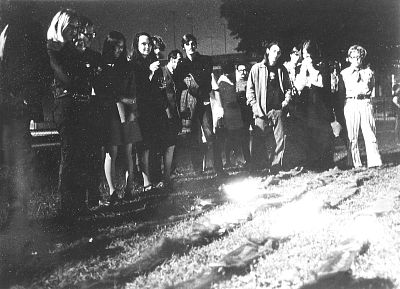
They, of course, have come to this through an involvement with the phenomenological, or ontological, debate that runs through the art of our century since Duchamp. Indeed, the admiration of these artists for Duchamp lies mainly in the fact that his activities initiated that debate and sustained it; though whether he expected or even desired such a debate is highly problematic—for his motives seem to have been conditioned more than anything by a sort of dandyish aloofness. Thus, when he proposed a series of common objects as works of art it was, at first, more to state a position than to broaden current concepts of the aesthetic: to transcend taste, as he put it, by “indifference,” (4) and he thought so little of the actual objects that most of them have been lost. Later, however, he coined the term “Readymades” for these objects and justified their exhibition on the grounds that “choosing” something was a legitimate alternative to making it—thus attempting to exhibit a urinal which he submitted to the New York Independents’ Exhibition of 1917 to provide “a new thought for that object.” This is not quite Suzuki's “new viewpoint,” but it could lead there; and, although almost nothing was known of Zen in the West in 1917, the description of Zen above, as aphoristic dialogue, irrational gesture and disciplined detachment, might equally be applied to Duchamp. Certain Futurist/Dadaist practices point in the same direction—especially the idea of the “gratuitous gesture” or act of calculated but random disruption which, by suddenly removing the mundane meaning from situations, is also reminiscent of Zen.
It was not until after the Second World War, however, that interest focused seriously on Duchamp and the Dadaists—significantly at the same time that it focused on Zen. The travesties that were perpetrated in the name of Zen at that time may seem amusing today; nevertheless, they reflect a mythos that left an indelible mark on later art, most especially through the activity of the American composer John Cage. Cage created art that comprehended not merely Duchamp's “new thought” but also Suzuki's more ambitious “new viewpoint.” Duchamp had accepted the category “art,” albeit of a highly intellectualized order, but Cage ended categories and assumed only the world (his paradigmatic, silent piano sonata of 1953 takes in the ambient noise of the concert hall and suggests Blake's view that, “if the doors of perception could be cleansed, everything would appear infinite.” It is somewhere in the gap between these two positions (once defined by Robert Rauschenberg as “between life and art”) that at least half of Post-War II art has been created.
Europe's most important post-war contribution to the debate carne from the French artist Yves Klein who was actually a student of Zen and other occult matters including alchemy, although his art shows the detachment of neither Duchamp nor Cage. Klein appropriated for art specific qualities and elements of the world, and perhaps because his position was less rigorously bounded than their’s, he produced tangible works at a much greater rate. His paintings made by the action of fire, water, weather and atmosphere, led to fire and water fountains and hinted at the “elementalist” activity of today. In the same way, his monochrome paintings hinted at “minimalism” (although they carried a ballast of almost medieval symbolism). But Klein was never able completely to sever his attachment to the salon and a sort of theatrical presence. Takis (in the present show), who met Klein through his own interest in Zen, ended a brief attempt at collaboration in 1956, for these reasons; and whilst Haacke and Van Saun both acknowledge Klein they are far more detached, far less manipulative, and evidently more aligned to that “direct and primitive contact with the world” of which Merleau-Ponty speaks.
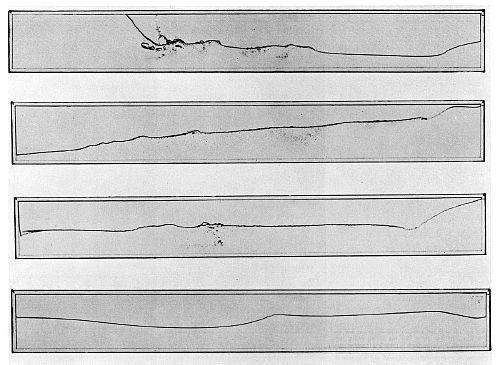
The relevance to art of Merleau-Ponty's thinking became apparent only as the 'sixties progressed. His aim, to restore the primacy of perception, or of what he took to be its equivalent, the primacy of things, found its parallel first in the “descriptive” novels of the French writer AIain Robbe-Grillet who eliminates plot, character, explication and psychology from his work in favour of an impenetrable and minutely detailed series of tableaux. This “phenomenological reduction” of the French “New Wave” novel, together with its heightened emphasis on the tangible world, seems to have influenced the thinking of Donald Judd, who became a leader of the so-called “Minimalist” movement in sculpture; indeed, Judd's reviews for Arts Magazine would meld smoothly into a Robbe-Grillet novel whilst, in 1963, his review of the work of Kenneth Noland amounted to a personal manifesto: “Painting now,” he wrote, “is not quite sufficient ...it lacks the specificity and power of actual materials, actual color, actual space.” (5) It is this “specificity and power” of the “actual” which has preoccupied so many artists since, which connects them to phenomenology, and which brings us to the threshold of this exhibition.
Since the early ’sixties, this preference for actuality has involved an almost programmatic rejection of those features by which twentieth century sculpture has been known: biomorphism, expressive gesture, autographic surface and formal complexity have all been discounted. At first, form became simplified and tautological, with no reference outside itself; its elements modular and repetitive; syntax became explicit, and colour was simplified or suppressed in favour of neutral tones or the brute nature of the medium. Taken further, form has become a statistical datum, contingent on chance and unstructured materials; and finally the artist has moved his activity out of the studio, and even the factory, into nature and even human nature. This last development, which the art audience must approach mainly through reportage and documentation, might be called meta-phenomenology, since its aim, one step beyond Cage, is to aestheticize not only the perceptual but the conceptual world as well. (6)
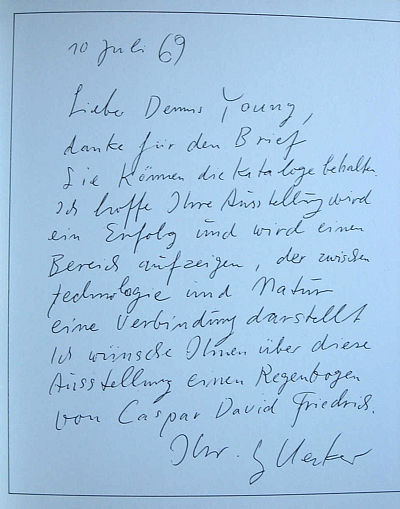
In a way there are parallels to this sort of escalation in science, where the old is continually being relegated to a sub-category of the new. Indeed, among recent global tendencies in science, there is one,”General System Theory,” (7) that has caught the imagination of certain artists. G.S.T. is an attempt to transcend the limitations of the analytic method through an assumption that somehow a system is greater than the sum of its parts – one of the premises of phenomenology. The increasing popularity of G.S.T. stems from the insight that there may be an isomorphism between the structures of events in disciplines that have hitherto been unrelated. Its attention is focused particularly on “open” systems, like biological organisms, that can be sustained by the input of new energy, whilst “closed” systems, in contrast, having no source of input, become steadily more run down, or less and less “organized,” until they reach a state of entropy—a sort of stasis or repetitive sameness). (8) See, for instance, Hans Haacke’s Large Wave that slows down to complete equilibrium if left alone for an hour.
The notions of entropy and systems theory, in their broadest sense, can be observed in the present exhibition most conveniently in the work of Hans Haacke and John Van Saun --not by the demonstration of a formal analogy, but from the evident fact that their work makes systems “actual.” Van Saun, for instance, may be said to realize a “closed” system. like Haacke’s “Wave” every time he sets in motion his fires (they burn out!).
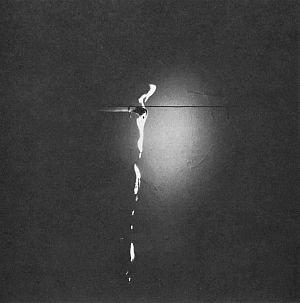
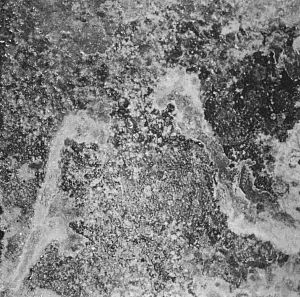
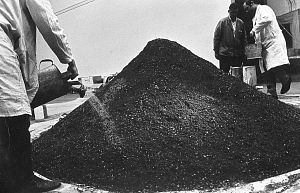
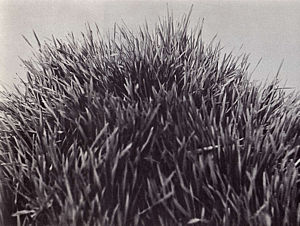
The same can be said for his Burning Polyethylene or his Bread Mould, which latter, though absorbing spores from the atmosphere will ultimately die for lack of a supply of the moisture that keeps them alive (hopefully for the duration of the exhibition!). The same can be said of Haacke’s Earth Seeded with Winter Rye as well as his closed system of the Large Wave. But he sometimes also creates “open” systems: energy-absorbing and self-sustaining. Where Van Saun's fires are, as it were, sealed off and an entropic, (i.e. “used-up”) tendency encouraged, Haacke will tap a source of energy that sustains the work in equilibrium as in his High Frequency Travelling Discharge seen below.
This, indeed, becomes an important distinction between two artists who are sometimes bracketed together. They were for instance among a group of five commissioned to activate an area of New York’s Central Park in 1967 with fire, water, air, smoke and so on. Other distinctions are also observable. Van Saun is more concerned with the visual results of the system than with the system itself. The same cannot be said of Haacke, a more cerebral artist who tends to start, like Duchamp, from an intellectual challenge. (Duchamp wrote, “Make a sick picture”, Haacke writes, “Make something indeterminate.” (9) (10) Van Saun steers clear of conceptualizing; his motives, although concrete and specific, are emotional and visual; his desire to work with pigeons for instance begins at the retina, and his intention is contained in what you see. Certainly the moulds and corrosions exemplify the second law of thermodynamics (that entropy, or disorganization, increases in a closed system), but Van Saun is not keyed into this intellectually so much as emotionally—through the poignancy of things that crumble to decay—and even this is second to an awareness of the phenomenon itself.
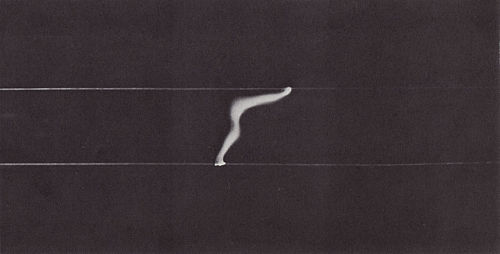
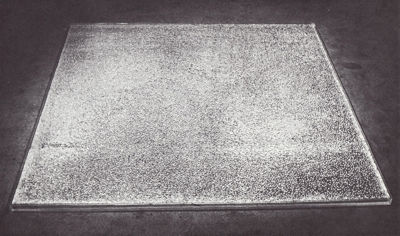
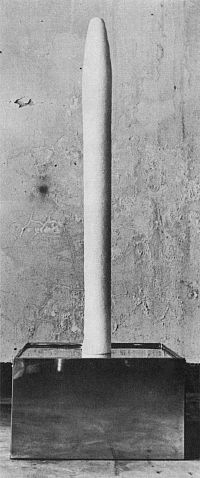
Both of these artists, in individual ways, began their art with an interest in “change,” and came to their present position through an involvement with kinetic or light art, which in Haacke's case started in the late ’fifties. Before this, Haacke had made “weathered” paintings rather under the influence of Klein. The same artist may be said to have a bearing on Haacke's early kinetics through their mutual connection to the Zero Group in Dusseldorf. However, in 1961, Haacke came to the U.S.A. on a Fulbright Fellowship, and almost at once began to replace his Zero-influenced reflective materials with transparent plastic, and to incorporate liquids which had not only reflective and refractive properties but were unstable and, under gravity, could be harnessed for kinetic light effects of an almost natural order: drip boxes, viscosity bottles and wave boxes which required energizing merely with the human hand, were followed later by condensation boxes whose “kinetic” content was motivated without the intervention of human or mechanical power at all. The full implications of this at that time, however, were not clear. At first, Haacke saw the condensation box more in terms of intellectual elegance and the slow beauties of its kinesis and light. Later he realized he had created a “self-stabilizing” system, and since then his scope has broadened in the way already mentioned.
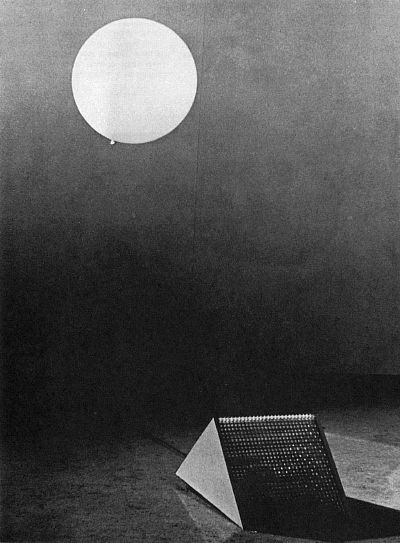
But the solutions to his self-posed problems remain elegant. Often he simply inserts an irritant into the flux of the natural world (a refrigeration column into a humid room, an electric potential across parallel wires, a fan into still air, a rope across the falls at Ithaca in mid-winter); (11) At other times he annexes and isolates natural phenomena (water, eggs, grass mounds), and this he continues to do with an economy, clarity and aptness that would retain for him a place in the aesthetic realm, even if the works themselves were intellectually less compelling.
Most recently, Haacke has turned to “documentary” and “conceptual” art (given its post-War debut when Yves Klein signed his name to the underside of the sky at Nice in 1946). Haacke earlier rejected an idea to sign his name to the weather because he wondered if some estrangement from the normal was not indispensable—a transposition supposedly to the sacrosanct arena of the museum—or at least the “museum without walls” of the art periodical. He has recently taken up the theme of weather again by proposing to use a meteorological chart, and also proposed as art the hospital identification sheet issued when his son was born.

These tokens stand for systems that existed on a particular date, but they draw one's attention to those systems, not to themselves, and are not to be mistaken for the art work: the art work is the concept of the system. This makes art an entirely subjective and disjunctive category (12) but it has still not resolved the paradox posed by Duchamp that although anything might be art (at least in the phenomenological sense) some sort of special venue may be necessary in which to separate it off from life and thus remove its mundane meaning, at least until our perceptual education is radically changed.
In spite of the different look of his art, Takis, “gai laboureur des champs magnetiques,” as Duchamp punned, takes common cause with other artists in the exhibition. Where Ross might be seen as the sculptor of ambient light, Takis recruits and concentrates magnetic force; and just as the kinetics of Haacke and Van Saun are highly attenuated, so is that of Takis—for whom movement exists less for its own sake than to give substance to the otherwise insubstantial, as fields of force shift or collapse. The magnets function like the fans used by Haacke, they generate forces known only through their effect on materials nearby: just as light illuminates the material world, so the material world itself illuminates magnetic fields or currents of air.
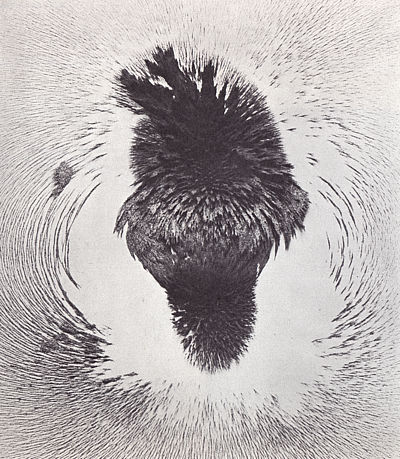
Takis admires the Eastern philosophers and especially the Yogi Milarepa, but though he has read Buddhism he is not a disciple of Zen. His particular phenomenology has its roots more in the primitive apprehension of dry slopes and river beds during his childhood in Greece, of the marks of struggle that remained from the erosive surge of water and the resistance of rock. It was such fascination with the evidence of natural forces that prompted his first true magnetic sculpture in 1958, when he arranged three nails, restrained by nylon thread, to float under the influence of the magnet from an old magneto.
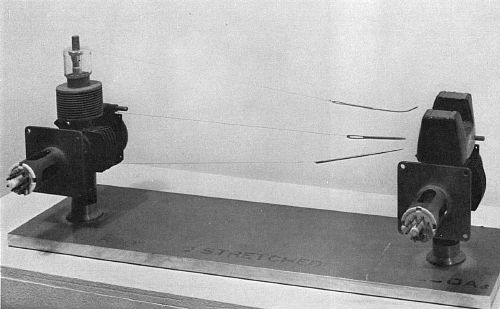
He had used magnets earlier than this, but in structures more akin to the surreal linear sculpture of Gonzales, structures animated by some sort of “presence.” It was these early works, some of which were already called “Signals,” that drew to him the attention of Robert Godin the Zen Buddhist who introduced him to Yves Klein, prior to their short-lived collaboration. Since then, however, the surreal element in Takis’s work has given way to a more pure phenomenology, enhanced by familiarity with the thought of Duchamp. Thus his use of undisguised magnetic objects and other trouvailles stands not as a token of mystery but of an aesthetic freedom or “indifference” that implies total concentration on the invisible force.
Charles Ross's prisms have evident affinities to the austere forms of Robert Morris or Tony Smith, but they offer a quite different, multivalent experience. Part of their point is that they “feed,” as he puts it, on their environment: one sees not only the prism, but, displaced through it, the activities of other people—the artificial “ecology” of an urban situation is brought into sculpture as it has been brought into avant-garde dance (in which Ross has also been an innovator). (13) This is apart from the spectral and spatial displacements they engender. The prisms thus not only have their own phenomenological status, but are instruments through which the status of phenomena nearby is changed. (14)
Surprisingly enough the works are not opalescent—if there were no environmental features around to reflect light, then there would be no refraction of light in the prisms, except from their own edges, and they would remain clear. As it is, the pieces have the effect of trapping energy from the chance events around, and of constantly changing their milky, luminescent note as the day changes and as we move among them.
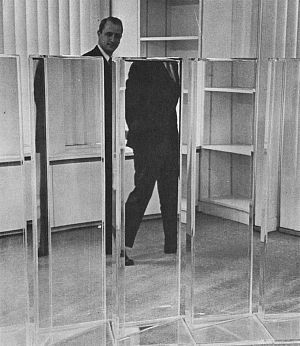
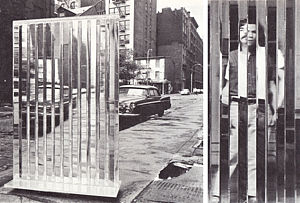
They become thus analogues of highly simplified open systems, reactivated continuously by new sources of natural energy. In this sense, because they are transparent, even Ross's serial works, like 7 Prisms, have an essentially less entropic undertone than much serial (i.e. modular, repetitive) sculpture. Nevertheless, Ross has moved on from the serial idea because it lays too much stress on the work as object and has come to see that types of cinematic sequence can be generated through the prism, and this seems to be the path that he will shortly explore.
Meantime we are left with these gorgeous lambent blocks that capture light almost like Haacke captures atmospheric moisture or Van Saun seduces his pigeons. Ross, like Takis, makes an electro-magnetic force perceptible in its nature: light is seen through the refractive properties of the prisms as it scatters from point to point in the environment. It is as if we were in the presence of the alembic of the alchemists themselves.
The exhibition, in sum, is locked into a sensibility which, although it has taken over fifty years to mature, in many ways defines the ’sixties. It shares a unique aesthetic, stemming from the economy, even parsimony, with which the materials are used; the restraint, amounting to diffidence, with which the artists approach their forms; their minimal interference with the elements they harness. Such simplicity propagates a new beauty by enhancing our apprehension of the phenomena themselves—their essentially restless, yet reticent, presence in all our lives.
